Creative Approaches to Revamping Your Home Lounge

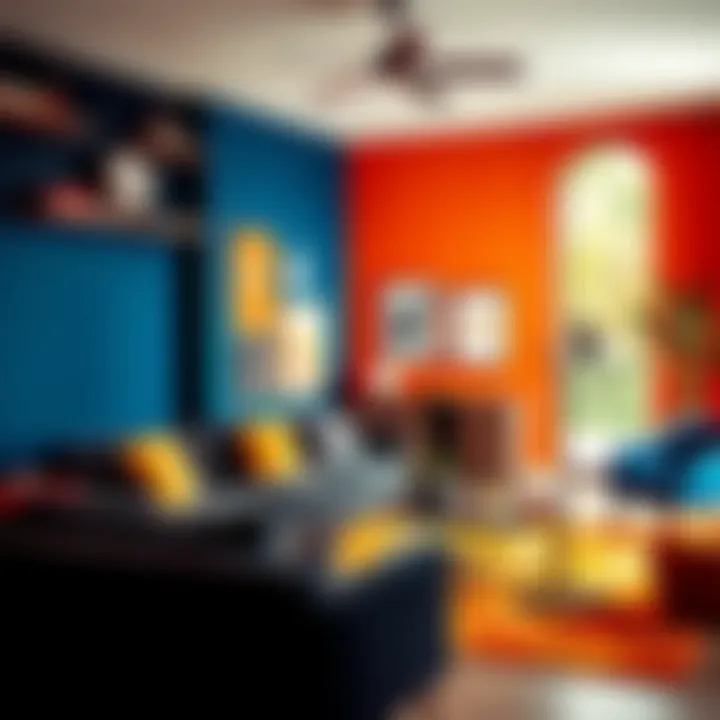
Intro
Creating a home lounge that is both functional and visually appealing can feel like a tall order. This space often serves as the heart of the home, where families gather and guests are entertained. Therefore, designing a lounge reflects not just personal style but also the lifestyle and needs of its inhabitants. In today’s article, we will explore innovative concepts that breathe fresh life into home lounges. From carefully curated color schemes to smart furniture choices, each element plays a vital role in crafting a unique atmosphere. We aim to provide you not just with ideas, but also with the rationale behind them, so you can make informed decisions while embracing your creative flair.
Furniture Design Trends
As times change, so do the trends in furniture design. Homeowners today are looking for styles that harmonize with their everyday lives, leading to a blend of comfort, functionality, and elegance.
Current Trends in Furniture Design
One of the key trends is the incorporation of multi-functional furniture. For instance, sofas that convert into beds, or coffee tables that double as storage units are becoming increasingly popular. This practical approach caters to the limited space many contemporary homes face, allowing individuals to maximize their areas without sacrificing style.
Moreover, sustainable design is gaining traction. Furniture made from recycled materials or sustainably sourced woods speaks to a growing desire for eco-friendly living. A mix of vintage finds and modern pieces can create a unique aesthetic that tells a story while minimizing environmental impact.
"Sustainability isn't just a trend; it's the way forward for a better living environment."
Influential Designers to Follow
Keeping track of the influential designers can offer valuable insight. Think of names like Philippe Starck, who blends playful designs with practicality, or Patricia Urquiola, known for her innovative style that is both modern and warm. Following these designers can inspire homeowners to step outside traditional boundaries and embrace a more eclectic approach to their lounge spaces.
Practical Tips for Furniture Selection
Once you’ve got your trends in mind, the next step is practically selecting your furniture. The right choices can lead to a harmonious living environment where form meets function seamlessly.
Choosing the Right Materials
Understanding the materials is essential. Natural materials like wood, leather, and stone add tactile warmth and depth to a lounge. In contrast, synthetic options can offer durability and ease of maintenance. Balancing these can create a layered look that feels inviting yet sophisticated.
Maximizing Space with Smart Furniture Choices
Opting for pieces that fit your space is crucial. Measure your lounge thoughtfully and visualize how each item will interact with the layout. For instance, modular sofas can adapt to changing needs and ensure that the space remains flexible. Additionally, using furniture with legs can create a sense of openness. It draws the eye upward and makes even the coziest lounge feel more spacious.
Consider diving deeper into industry insights at Britannica or explore community ideas at Reddit as you embark on your design journey.
Understanding the Home Lounge Concept
In modern residential architecture, the home lounge plays a pivotal role in creating a welcoming atmosphere. It's not merely a space of leisure; it embodies the essence of comfort and relaxation, serving as a communal hub or retreat from the daily grind. Grasping the concept of a home lounge is vital for homeowners and designers alike. It sets the tone for the household, influencing both the aesthetic and functional dynamics of the living environment. By understanding this space, one can infuse personality while ensuring practicality.
Defining a Home Lounge
A home lounge can be defined as a designated area where individuals congregate to unwind, socialize, or simply enjoy quiet time. It typically features comfortable seating arrangements, ambient lighting, and is often decorated with art and personal items that reflect the owner's taste. Unlike a formal living room, which might be reserved for guests, the lounge is more intimate and often unrestricted by traditional decorum. This flexibility allows for creative expressions in design, turning the lounge into a canvas for personal style.
In plain terms, think of the lounge as the heart of the home – designed to breathe life into everyday interactions and foster connections. It combines functional elements like seating and surfaces for activities with an inviting aura. A well-defined lounge area encourages relaxation and could serve various purposes, from movie nights to book clubs.
The Significance of a Lounge in Modern Living
The modern lifestyle has evolved rapidly, creating a need for multifunctional living spaces that adapt to diverse activities. The lounge emerges as a focal point in this context. Here are a few reasons why a lounge matters:
- Fostering Community: The lounge acts as a gathering space. Friends and family can come together, reinforcing relationships and building memories.
- Creating Sanctuary: After a long day, a cozy lounge is essential. It offers a retreat, a space for solitude, and relaxation, often decorated in soothing palettes and textures that invite calmness.
- Displaying Personality: In a lounge, homeowners can showcase their individuality through curated decor. Whether through a collection of books, artworks, or family photos, this space reflects personal stories.
- Maintaining Flexibility: A well-designed lounge can adapt to various functions – whether it’s a casual coffee catch-up or hosting a game night. It's about creating an atmosphere that suits multiple occasions while remaining comfortable and inviting.
"The lounge is more than just a room; it's a feeling of home."
In sum, the lounge embodies the spirit of contemporary living, balancing comfort, style, and functionality. As more people seek to transform their homes into sanctuaries, understanding the essence of this space becomes ever more important.
Establishing a Functional Lounge Layout
Designing a lounge is about more than just aesthetics; it's about creating a space that functions well for everyday living. Establishing a functional layout ensures that the lounge becomes a hub for relaxation, socializing, and enjoying leisure activities. A well-thought-out design can enhance comfort, facilitate movement, and promote an inviting atmosphere. Here, we'll explore how to analyze space dimensions, apply effective furniture arrangement strategies, and maintain a smooth flow between different zones.
Analyzing Space Dimensions
Before diving into design and decor, one must take stock of the available space. Measuring the lounge is more than just jotting down numbers—it's about understanding the opportunities and limitations that those dimensions present. Start by measuring the length and width of the room, then consider the height of the ceilings. This information lays the groundwork for making informed decisions.
When people think about dimensions, they can get caught up in the specifics and forget the overall feel. Imagine walking into the room. Is it cramped or open? How does the arrangement of furniture affect the ambiance? A larger space offers versatility, allowing for sectional sofas, expansive coffee tables, or even a cozy reading nook. In contrast, small lounges may benefit from lighter furniture options and multi-functional pieces to maximize every inch.
"An understanding of space is foundational; it defines the potential of what can be achieved in your lounge."
The layout should consider not only the usable area but also how natural light travels through the room. Where the windows are located can influence furniture placement, especially regarding seating that faces the light to foster a warm atmosphere during the day. Overall, analyzing dimensions involves looking beyond numbers, focusing instead on how to create flow and functionality.
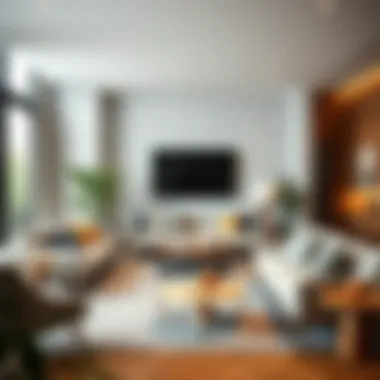
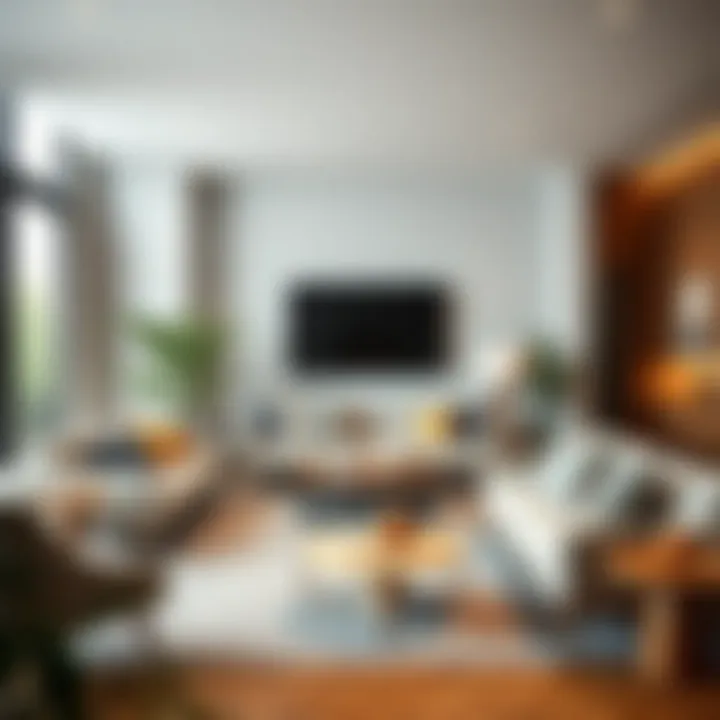
Furniture Arrangement Strategies
With the measurements firmly in mind, it's time to consider how to arrange the furniture. Effective furniture arrangement transforms a lounge from a mere room into a living environment. The principal aim should be to encourage conversation while providing cozy areas for relaxation. Here are some tips to consider:
- Anchor the space: Start with key pieces like sofas or chairs that will serve as the foundation of the arrangement.
- Create conversational zones: Group chairs and sofas in a way that facilitates social interaction. It's important to ensure that seating faces one another rather than being placed in opposing corners of a room.
- Utilize area rugs: Rugs can help to define spaces within the lounge, breaking a larger room into smaller, cozier sections.
- Be mindful of pathways: Ensure there is enough space between furniture for easy movement. Aim for a clear passage that does not disrupt the flow.
It’s vital to have balance throughout the arrangement. Incorporating various furniture heights, textures, and shapes creates visual interest. For example, combining a low-profile couch with tall lamps or art can give the room depth and prevent flatness.
Creating Flow Between Zones
An engaging lounge layout allows for distinct yet complimentary zones, ensuring ease of movement while maintaining a cohesive look. This balance can be achieved through strategic furniture placement and the clever use of accessories. Here’s how:
- Use furniture as dividers: Sofas or bookshelves can delineate different areas without the need for physical walls. This provides the feeling of settling into a space while still being part of the larger lounge environment.
- Adopt unified materials: Keeping a consistent design language with colors and patterns across zones aids visual flow. This doesn’t mean everything has to match, but complementary elements can tie different areas of the lounge together.
- Incorporate multifunctional pieces: Ottoman that can serve as extra seating or a coffee table can help maintain fluidity while minimizing clutter.
Creating this seamless flow gives your lounge an inviting atmosphere and encourages a natural transition from one section to another. Whether it be a reading nook, an entertainment area, or simply a space for relaxation, every zone should feel deliberate yet interconnected.
In summary, establishing a functional lounge layout is a cornerstone of effective home design. It directly impacts how one experiences the space, dictating not just movement but the very atmosphere within. The combination of thoughtful dimension analysis, strategic furniture arrangement, and flow enhancement lays the groundwork for an inviting and practical lounge.
Selecting Appropriate Furniture
Selecting the right furniture for your home lounge is crucial. It's not just about filling a space, but creating an environment that resonates with your lifestyle. The right furniture can transform a lounge from a simple sitting area into a sanctuary of relaxation and social interaction. It shapes the very essence and functionality of the space you spend your leisure hours in. Therefore, understanding what to consider when choosing furniture is paramount.
When you thoughtfully select furniture, you're essentially setting the tone for the entire room. This process incorporates not only aesthetic choices but also practical aspects, such as how the pieces will coexist within the overall layout. Proper furnishings create an inviting atmosphere and ensure that your lounge is functional for gatherings, quiet evenings with a book, or family movie nights.
Types of Furniture for Lounges
The types of furniture you choose will largely depend on your personal style and taste as well as the lounge's size and function. The following are some critical pieces to consider:
- Sofas and Couches: The cornerstone of any lounge, these provide seating and comfort. Opt for styles that encourage conversation and relaxation.
- Chairs: Accent chairs or recliners can offer additional seating while contributing to the overall decor. Consider types like wingbacks for a classic feel or modern lounge chairs for a contemporary touch.
- Coffee Tables: These serve both practical and decorative purposes, perfect for placing drinks or books. Choose one that complements the height of your seating.
- Side Tables: These small additions can maximize functionality, allowing guests to place their belongings within easy reach.
- Storage Solutions: Consider incorporating storage ottomans or shelves to keep clutter at bay while enhancing the room's aesthetics.
Each piece serves its purpose, but together, they compose a harmonious and inviting environment.
Balancing Comfort and Style
Finding the sweet spot between comfort and style is a challenge that many face. A beautifully styled lounge that isn't comfortable isn't going to be used much. Prioritize materials that are inviting such as soft linens, plush leathers, or warm woods. Here are a few tips:
- Test Before You Invest: Sit on sofas, lean back in chairs. Comfort should be your priority.
- Cohesion is Key: Choose pieces that work together in both color and texture—this will enhance the style without compromising comfort.
- Layer Up: Mix and match different seating options. A sleek modern sofa paired with soft chunky chairs can create both a chic look and a welcoming vibe.
- Personal Touches: Don't forget to add your personal flair, such as cushions or throws, that makes the space not only stylish but distinctly yours.
Sourcing Quality Materials
Quality should not be an afterthought when selecting furniture. Investing in well-made pieces can save you money and headaches in the long run.
- Research Brands: Look into brands known for quality craftsmanship. This matters especially for major pieces like sofas or dining sets.
- Explore Materials: Comfortable fabrics should stand the test of time. Natural fibers like cotton or wool are not only sustainable but hold up well.
- Consider Sustainability: As eco-friendly practices rise, sourcing sustainable materials is increasingly viable. Think about woods from recycled sources or fabrics made from recycled plastics.
Quality is more than just how something looks; it’s about durability and the impact on the environment. Investing in better materials will yield long-term value and satisfaction in your home lounge.
Color and Texture Selection
Color and texture are vital elements when designing a home lounge. They hold the potential to influence moods, define spaces, and create welcoming environments. A space filled with the right shades and tactile sensations can transform a standard living area into a haven of comfort and style. The heart of a lounge lies not just in its functionality but also in its capacity to evoke emotions and set an inviting tone for relaxation and social interaction.
Understanding Color Psychology
Color is not merely an aesthetic choice; it's an atmospheric builder. Different colors can elicit varied emotional responses. For instance:
- Warm colors like red, yellow, and orange can stimulate energy and encourage conversation. These hues might work best in lounge spaces where gatherings take place, creating a lively and engaging atmosphere.
- Cool colors such as blue, green, and violet have a calming effect. They are frequently favored for lounges designed as serene retreats, places for unwinding after a long day.
Utilizing color psychology involves understanding one's personal preferences, as well as the intended atmosphere of the space. For example, if creativity flows in a cozy environment, incorporating splashes of teal or sunflower yellow can invigorate the spirit. When painting the walls, consider a color that harmonizes with an overall theme; perhaps deep navy to contrast with light, airy furnishings.
Moreover, colors can also influence space perception. Lighter shades generally expand a room, making it feel larger, while darker tones can create a cozy, intimate vibe. By selecting an appropriate color palette, homeowners and designers can frame the lounge's purpose, guiding visitors through a visual and emotional journey.
"Colors, like features, follow the changes of the emotions."
– Pablo Picasso
Combining Textures for Depth
Textures play an equally crucial role in crafting an inviting lounge. They introduce layers to the visual landscape, providing tactile experiences that soothe or invigorate. Here are some ways to blend textures effectively:
- Fabrics: A mix of textiles—such as soft velvet cushions paired with a sleek leather armchair—can yield an interesting contrast that catches the eye and invites touch.
- Rugs: An area rug can anchor the space, adding warmth and comfort underfoot. Consider a shaggy rug with a smooth coffee table for a balance of styles.
- Natural Elements: Incorporating materials like wood or stone can ground the design and add an organic feel. A reclaimed wood coffee table can lend rustic charm, while metallic accents introduce a modern twist.
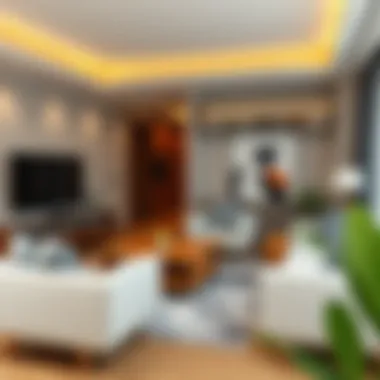
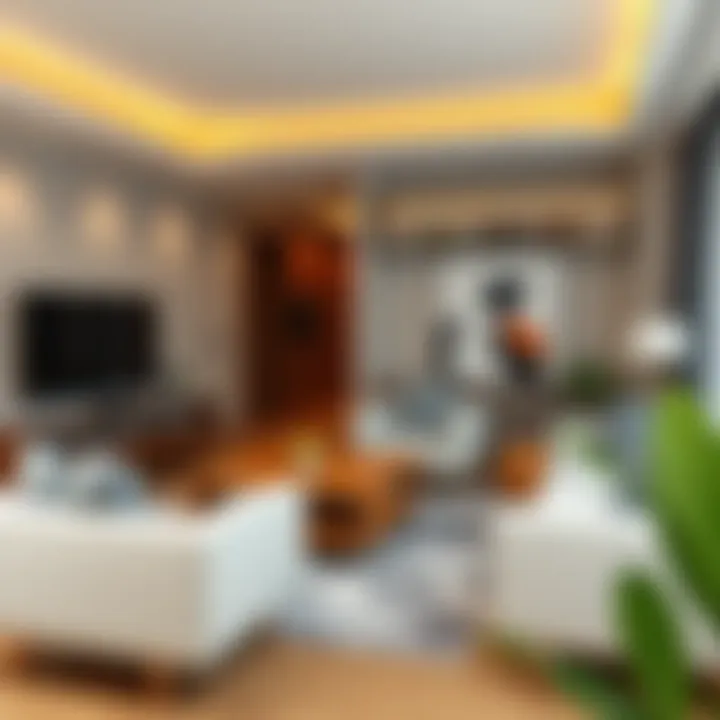
Combining various textures promotes depth and multidimensionality. For instance, a soft throw blanket draped over a woven chair not only looks appealing but also invites interaction. Don't shy away from mixing rough and smooth surfaces, as this juxtaposition can invigorate the lounge's character. The goal is to create a harmonious blend that aligns with the overall vision for comfort and style.
Lighting Approaches for Home Lounges
Lighting can make or break a space. In a home lounge, it plays a pivotal role not only in aesthetics but also in functionality and mood setting. A well-lit lounge invites warmth; it creates an atmosphere perfect for relaxing or entertaining. When we think about lounge designs, lighting should never be an afterthought. Instead, it deserves thoughtful consideration to elevate the overall experience in your home.
Key elements to consider include:
- Functional placement of light sources
- Layering of lighting to create depth
- Enhancing the natural light dynamics
With these considerations in mind, let’s dive into two critical aspects of lighting—Natural Light Utilization and Layered Lighting Techniques.
Natural Light Utilization
Natural light is your best friend when designing a lounge. It’s organic and provides a quality that artificial light often struggles to replicate. Maximizing natural light can lead to a vibrant and inviting space. Start by assessing window placements and sizes. Large windows or glass doors not only draw in sunlight but also create a seamless connection with the outdoors.
To make the most of this light, consider these tips:
- Window Treatments: Opt for sheer curtains or blinds that can be adjusted easily. This will allow light in while still providing privacy.
- Reflective Surfaces: Use mirrors and light-colored furniture to bounce sunlight around your space. This creates an illusion of a larger, airier room.
- Strategic Layout: Arrange your seating to face windows. This not only encourages conversation but also makes the most of the daylight.
"The magic of natural light is that it transforms; it creates mood and depth in ways that artificial sources can’t."
Layered Lighting Techniques
While natural light is essential, it's also important to incorporate various types of artificial lighting for different needs. Layered lighting involves combining three primary types of lighting: ambient, task, and accent. This enables you to set the tone for any occasion, be it a cozy night in or a lively gathering with friends.
Here’s how to effectively layer lighting in your lounge:
- Ambient Lighting: This is the main source and provides overall illumination. Ceiling fixtures or recessed lighting can serve this purpose. Choose fixtures that align with your lounge's style.
- Task Lighting: Consider what activities the lounge will host. If reading or board games are commonplace, add table lamps or standing lights where those activities occur.
- Accent Lighting: Highlight artwork or architectural features with spotlights or wall-mounted fixtures. This not only draws attention but also adds character and depth to the lounge.
Incorporating varied light sources allows flexibility in mood and purpose in your lounge design. Think about dimmers to adjust the brightness, enabling you to transition from a bright, lively atmosphere to a soft, intimate setting effortlessly.
By harmonizing natural and artificial lighting methods, you optimize the function of your home lounge while enhancing its aesthetic appeal. The right lighting approaches can transform your space from drab to dynamic.
Incorporating Accessories and Art
When it comes to shaping the essence of a home lounge, accessories and art play a pivotal role. They have the power to breathe life into your space, transforming it from a mere functional area to a warm and inviting sanctuary. By thoughtfully selecting decorations and art pieces, one can convey personal style and create atmospheres that resonate with comfort and sophistication.
Incorporating accessories is not simply about filling empty spaces; it’s about showing off individuality and quality. Accessories such as throw pillows, books, and unique decorations not only mirror the inhabitant’s personality but also enhance the overall aesthetic. Bold pieces can serve as conversation starters, while subtle tones can establish a calming ambiance. The whimsical shapes of pottery or the intricate patterns of area rugs often catch the eye, making them essentials in narrowing down the lounge's character.
Furthermore, artwork—be it paintings, prints, or sculptures—has the ability to evoke emotions and provoke thoughts. When chosen carefully, they can reflect hobbies, memories, or aspirations, adding depth and narrative to the environment. It's vital to recognize that these elements don't just hang on the walls or sit on tables; they dance around the atmosphere, swaying the mood of the room with every glance.
Below, we discuss two key areas in this domain: the selection of wall art and decor, and the choice of textiles and soft furnishings.
Choosing Wall Art and Decor
Wall art serves as a visual anchor to the lounge's overall charm. Selecting pieces that resonate with your taste—and even your ethos—can significantly enhance the room's character. To start this journey, consider the following:
- Theme Alignment: Choose art that fits within the broader theme of your lounge, be it modern, rustic, or eclectic. Each piece should harmonize with other design elements.
- Size Matters: A large canvas can become a focal point, whereas smaller pieces may benefit from being grouped in a gallery style. Keep balance in mind; the wall space should have a proportionate look to the artworks.
- Eclectic Mix: Sometimes a blend of different styles speaks volumes. Mismatched art and decor can tell a story, showcasing varied aspects of your personality.
- Visual Hierarchy: Not every piece needs to be front and center. Secondary or tertiary pieces can add layers to the atmosphere without overwhelming the primary focal point.
Additionally, decor items such as vases, sculptures, or even curated collections can solidify your vision, making rooms feel uniquely yours.
Textiles and Soft Furnishings
Textiles and soft furnishings add warmth and texture to any lounge. They are often understated heroes. Don’t underestimate the comfort they provide as they can change how an individual interacts with the space altogether. When selecting extentions like cushions, curtains, or throws, consider these aspects:
- Layering Textures: Using a variety of materials between rugs, cushions, and drapes introduces depth. Velvet cushions next to woven throws create tactile richness that invites touch.
- Color Coordination: Soft furnishings can incorporate colors that resonate with the paintings on the wall, or provide contrasting tones that invigorate the lounge, striking a balance between harmony and excitement.
- Practicality: Choosing quality materials that are durable and easy to clean helps maintain the lounge’s appeal over time. High-traffic areas demand fabrics that withstand wear without losing charm.
- Functional Design: Multi-functional pieces like ottomans or storage benches can double as decor while adding practicality.
Embrace the essence of tactility with these elements; they are not merely decorative but also integral to comfort. The objective should always be to merge aesthetic allure with everyday functionality, leading to a home lounge that feels personalized, invigorating, and above all, inviting.
Integrating Technology Seamlessly
Integrating technology into the design of your home lounge is far from just a trendy move; it’s a smart way to enhance comfort and utility. In today's fast-paced society, homeowners are increasingly looking for solutions that simplify their lives while creating a stylish environment. Technology can act as a bridge between aesthetics and functionality. When designed well, it harmonizes the lounge atmosphere without sprouting a sea of wires or odd gadgets cluttering up the space.
The idea is to incorporate tech elements that actually support daily routines. Picture this: smart lighting that adjusts to your mood, or a sound system that flows from one zone to another, whispering gentle tunes while you unwind. This section will delve into two crucial aspects: Smart Home Features and Entertainment Solutions.
Smart Home Features for Comfort
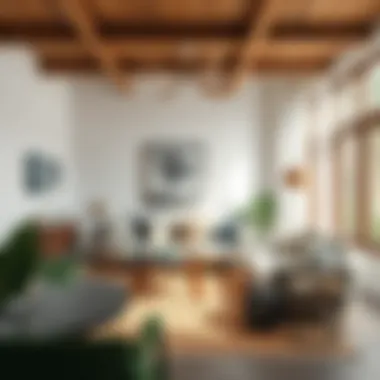
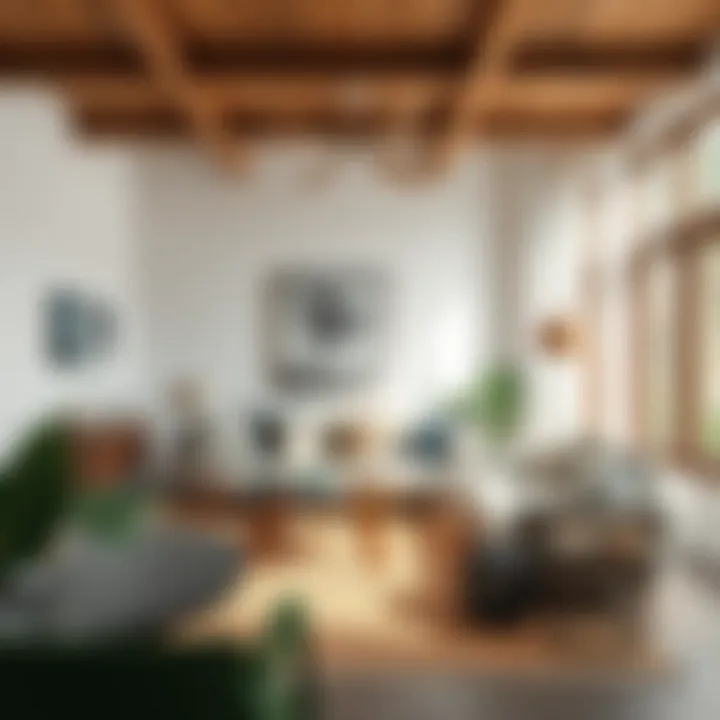
As we lean more on technology, smart home devices offer the opportunity to elevate the comfort level in the lounge. Here are some elements to consider:
- Smart Thermostats: These devices learn your habits and preferences to keep the temperature just right, without you having to lift a finger. Nest and Ecobee are among the frontrunners in this arena.
- Automated Blinds: Imagine sitting with a good book while the blinds automatically adjust to let in the perfect amount of light. Brands like Lutron and IKEA have options that can integrate seamlessly into your lounge design.
- Voice Assistants: Devices like Amazon Echo or Google Home aren’t just for playing music. They can control your lights, curtains, and even remind you of appointments—right from the comfort of your favorite spot.
Emphasizing these features can lead to a better balance of efficiency and relaxation. It’s about making your lounge a perfect retreat, where comfort automatically adjusts to your lifestyle.
Entertainment Solutions
Comfort and entertainment go hand in hand when designing a lounge. The key is to integrate entertainment solutions that enhance leisure time without overwhelming the ambiance. Think about these options:
- Integrated Sound Systems: Devices like Sonos offer multi-room audio that lets you listen to your favorite playlist just about anywhere in your home. This creates a cohesive audio experience that does wonders for gatherings.
- Smart TV Integration: A sleek flat-screen fitted neatly in the wall can act as a focal point and an entertainment hub. If you pair it with a good streaming service, you can watch movies, listen to music, or enjoy a video game in a way that feels immersive.
- Virtual Reality Setup: If you’re keen on something a bit more cutting-edge, a VR setup can be an exceptional addition. Just make sure it doesn’t clutter the space—that’s where thoughtful design comes into play.
"Integrating technology shouldn't overshadow personal style; it should amplify it, creating a harmonious balance between function and beauty."
Overall, blending smart technology into your lounge design isn’t just about gadgets. It's about crafting a stated sanctuary where everything works in unison, shaping experiences that are both meaningful and enjoyable. As you explore these ideas, consider how they resonate with your personal style and functional needs, ensuring your lounge stands out—both in aesthetic appeal and comfort.
Embracing Sustainability in Lounge Design
As we navigate through the complexities of modern living, the concept of sustainability has crept into every corner of our lives, including how we design our home lounges. This shift isn't merely a trend; it's a necessity for ensuring our living spaces align with responsible practices.
The importance of sustainability in lounge design lies not just in the environmental benefits, but also in enhancing the experience within the space. When homeowners consciously opt for sustainable designs, they contribute to reducing ecological footprints while creating serene and stylish environments. The blend of aesthetics and responsibility engenders a space that reflects not only personal taste but also a commitment to the planet.
Choosing sustainable practices can lead to tangible benefits:
- Healthier Indoor Environment: Materials with low volatile organic compounds (VOCs) can enhance indoor air quality, making for a cleaner, more breathable atmosphere.
- Resource Efficiency: Sustainable materials often come from renewable sources, conserving natural resources and reducing waste.
- Increased Property Value: Homes that incorporate eco-friendly materials and designs often see an uptick in market value as they appeal to environmentally conscious buyers.
By incorporating sustainability into every aspect of lounge design—from furniture choices to décor—the result is not only aesthetically pleasing but fundamentally aligned with a broader ethos of awareness and care.
Sustainable Materials Choices
When selecting materials for your lounge, it pays to think long-term. Opt for sustainable materials like reclaimed wood, bamboo, and cork. These options are not just eco-friendly but also add unique character to your space. Furthermore, many sustainable materials have excellent durability, meaning they can withstand the tests of time, making them a smart investment.
In addition, consider fabric choices for upholstery and curtains. Organic cotton, hemp, and linen are great alternatives to conventional textiles. Not only do they offer comfort and style, but they are also often produced with fewer chemicals, making them less harmful to both consumers and the environment.
Furthermore, when it comes to paint—look for brands that offer low or no VOC options. This small shift can significantly reduce indoor air pollution, enhancing your lounge's air quality and overall ambiance.
Eco-Friendly Practices
Integrating eco-friendly practices into your lounge design process can be quite simple. Here are some strategies to consider:
- Repurposing Old Furniture: Instead of tossing out your grandmother's vintage chair, think about how you can restore it or give it a new fabric. Not only is this sustainable, but it also carries a story that enhances your lounge’s character.
- Energy-Efficient Lighting: Replace old bulbs with energy-efficient LED lighting. These consume less power and last longer while providing the same, if not better, illumination.
- Incorporating Plants: Indoor plants such as snake plants, pothos, and peace lilies not only enhance the aesthetics of your lounge but also improve air quality and create a sense of calm.
By weaving these eco-friendly practices into your design philosophy, you contribute to a more sustainable world while crafting a lounge that resonates with comfort and style.
"Sustainability is not just about doing less harm, it's about doing more good."
By embracing these innovative, sustainable ideas, your lounge can become not only a personal retreat but also a beacon of environmental responsibility.
Personalization and Individual Expression
Personalization in home design serves as a reflection of a homeowner's character and lifestyle. In the realm of home lounges, this concept gains particular momentum as it melds comfort with individuality. The journey to express personal style in a lounge space allows individuals to break free from cookie-cutter designs and infuse their personal story into the decor. This innovation not only makes spaces inviting but also resonates emotionally with those who live in or visit the home.
When curating a home lounge, there's immense value in selecting elements that resonate on a personal level. Whether it's through color choice, furniture selection, or decorative accessories, every aspect can be tailored to reflect one's personality. An eclectic mix of items, like vintage finds paired with modern art, can tell a story that's uniquely yours. This approach goes beyond mere aesthetics—it creates emotional connections within the space.
Including individualized elements brings a host of benefits. For one, it cultivates a sense of ownership over the space. When a lounge feels like a part of oneself, it nurtures emotional well-being and relaxation. Moreover, personalized designs can often serve as conversation starters, inviting guests to engage with the stories behind your chosen pieces. However, it’s crucial to balance personal expression with practicality to ensure that the space remains functional and comfortable.
Curating a Unique Space
The essence of curating a unique space lies in making deliberate choices. When you step into a well-designed lounge, every item speaks a language of its own. Think about how to create that unique dialogue. Start off by selecting a cohesive color palette that resonates with your taste. Colors can evoke feelings and set the tone for the entire lounge. For instance, softer shades can instill calm, while bolder hues might create energy and liveliness.
- Personal art collection: Incorporate art pieces that reflect your personal journey or travel memories.
- Handcrafted items: Choose unique handcrafted pieces that tell a story or hold sentimental value.
- Statement furniture: Invest in a few key pieces that serve as focal points, drawing the eye and sparking curiosity.
Moreover, mix different styles—from modern to bohemian—to create a layered narrative. Combining textures such as leather, wood, and textiles can add depth, transforming the lounge into a realm of tactile exploration. Don’t shy away from unexpected pairings; sometimes, the odd couple creates the best conversation!
Incorporating Cultural Elements
Embracing cultural elements in your lounge not only personalizes the space but also fosters a connection to your roots or places that inspire you. Elements from diverse cultures can add vibrancy and history, encouraging an immersive experience within your home. For example, if you’ve traveled extensively, consider showcasing artifacts from those journeys as a form of storytelling.
- Textiles: Integrate fabrics with patterns from different cultures, like Moroccan rugs or Japanese kimono silk, to enhance textures and colors.
- Artifacts: Display pottery or sculptures that reflect the craftsmanship of different regions, adding a unique narrative.
- Culinary influences: Create zones that pay homage to culinary traditions, such as a lounge bar designed like a traditional tea house or wine space.
These cultural integrations don’t just beautify; they provoke curiosity and conversation, enriching interactions with family and friends. They create an atmosphere that encourages storytelling, reminiscing, and even learning about each other’s backgrounds. Thus, your lounge becomes not just a space for relaxation but a portal to a wider cultural dialogue.
"A well-designed lounge is more than aesthetics; it ultimately becomes a canvas for personal expression and cultural appreciation."
By focusing on personalization and cultural elements in designing your lounge, you create a space that's not just livable but livelily expressive—each piece narrating a chapter of your life or your heritage.



